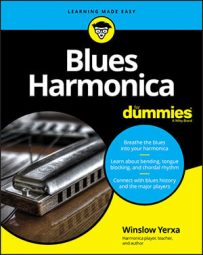Performing for an audience can be a major thrill; you just might get hooked on it as a harmonica player. But it can also be nerve-wracking, and it can be humiliating if it goes badly. To ensure that your musical performance goes well, spend a little time figuring out how to get ready, have a good time playing, and enjoy the results.
Preparing for a harmonica performance
To get your music, instruments, equipment, and yourself ready to play, follow the following advice:
Make a set list
Follow these steps to put together a set list:
List your songs on a sheet of paper in letters big enough to read if you lay the sheet on the floor.
Put the songs in set order — the order in which you’ll play the songs during your set or time onstage.
Next to each song, list its key and which harmonicas you need for that tune.
If you’re going to sing, you might also write in the first line of the lyrics, just in case you forget them.
Rehearse your parts
Practice singing each song from beginning to end, at the same volume level and with the same expression that you’ll use when you perform. Don’t just hum through bits of the tune.
Memorize the lyrics to each tune, and also have an unobtrusive cheat sheet with reminders.
Practice your harmonica solo spots, and memorize the first few notes of each solo. Play the solo over and over until it’s automatic. That way, if stage fright hits you along with the spotlight, you can go on autopilot until the deer-in-the-headlights syndrome subsides.
Model your onstage setup
When you rehearse singing or playing, stand the same way you will onstage, and if you’ll be holding a harmonica and/or a microphone while you sing, do that while you practice singing.
If you’re using your own harmonica microphone and amplifier, practice playing harmonica using the same combination that you’ll be using onstage.
Prepare your instruments and equipment
Make sure you have all the keys and types of harmonicas that you’ll need, and ensure that they all work properly and play in tune. Replace or repair any harps that aren’t performance-ready.
Don’t forget to bring your instruments or equipment to the gig. Make a list, and check it before you leave home.
Prepare a way to lay out your harps onstage so that you can quickly reach them, pick up the harp you need, and put down the one you’re done with. For example, you could use a small table, the seat of a chair, or the top of an amplifier. As long as you can get at your harps easily and they’re not in danger of being knocked on the floor, crushed, or inundated with beer, you should be in good shape.
Plan for an alternative in case your equipment fails, such as playing through a vocal microphone.
Relating to your audience
Audiences are out to have a good time and are looking to the musicians to help provide it. They want you to succeed and will cheer you on. You can return the favor by acknowledging them, feeling their goodwill, and letting it radiate back from you to them.
To put yourself and your audience at ease, say a few words. Just a few, something as simple as, “How’s everybody doing tonight?” You might mention the name of the tune you’re about to play and then get down to business.
When you talk to your audience, try to look just over their heads. They will see you looking sort of into their eyes, as if you’re talking to them personally.

